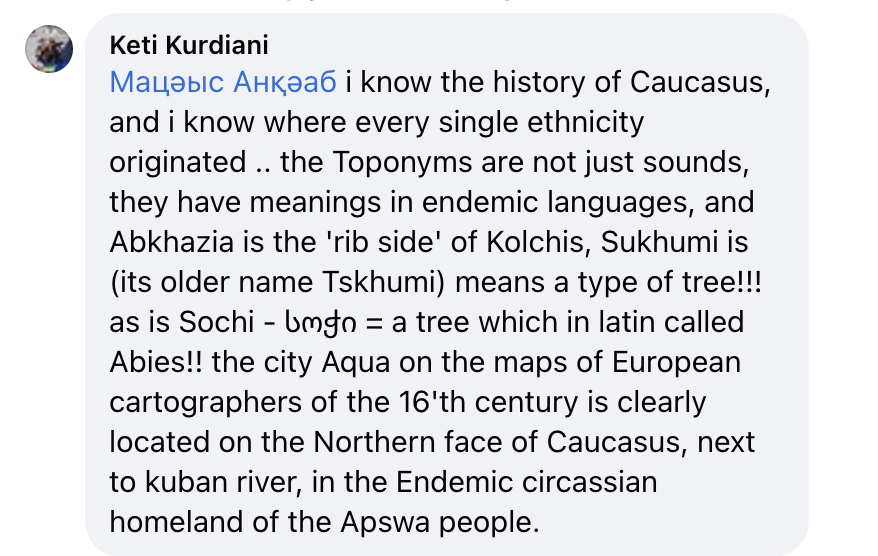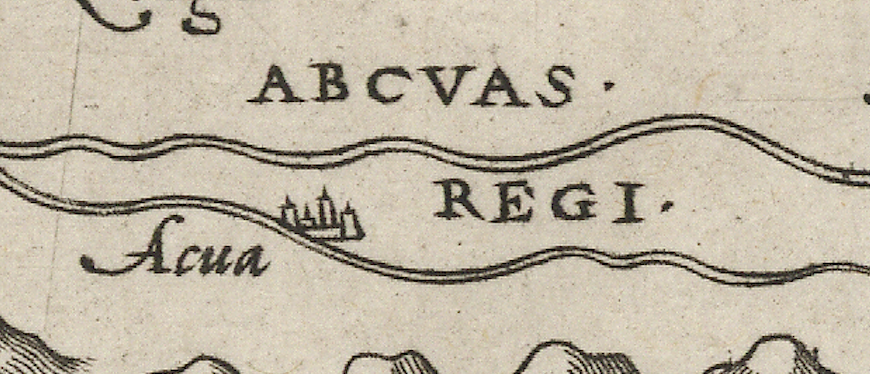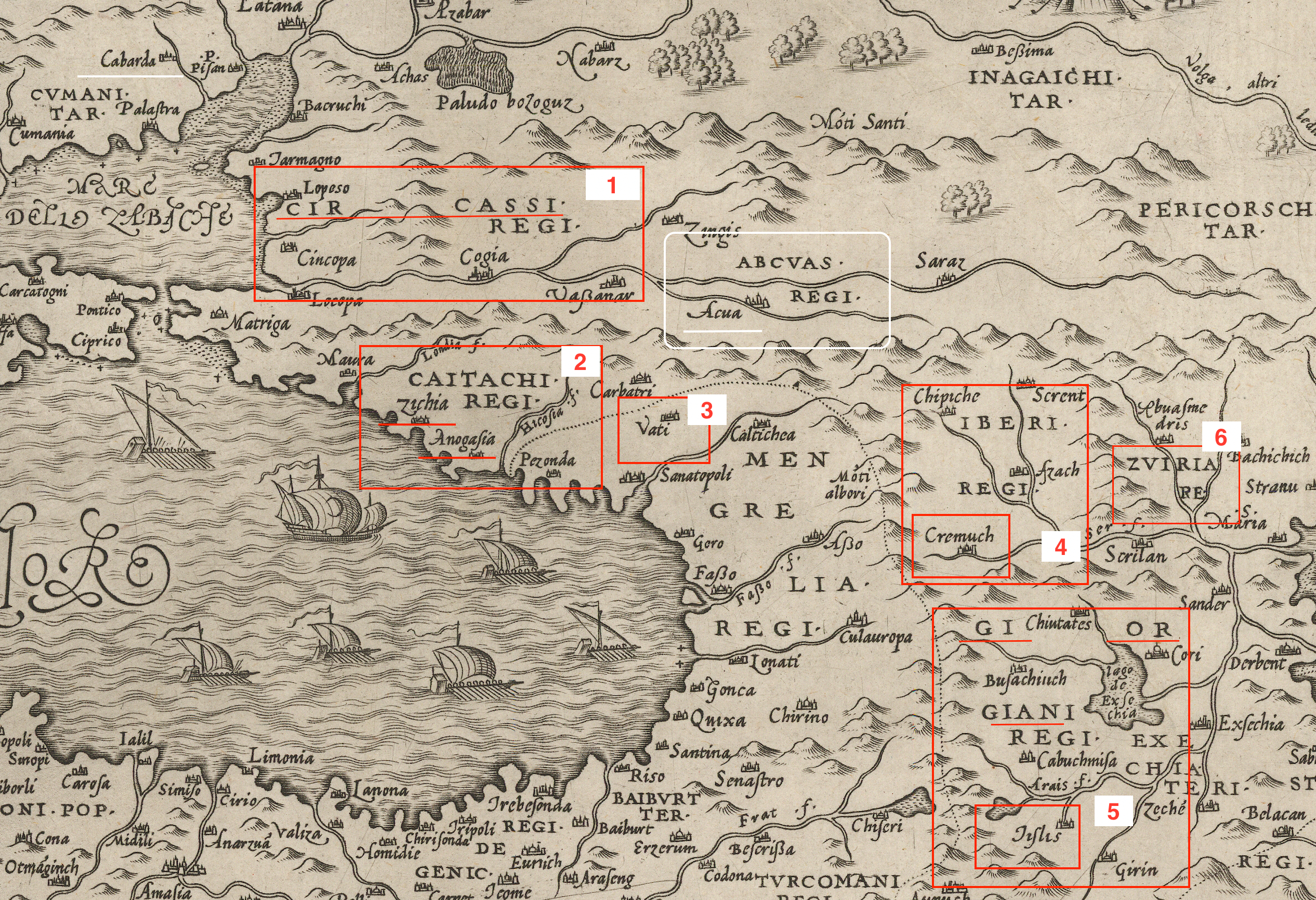Georgian Myths vs. Historical Facts: The Reality of Abkhazian History

Il designo della prima parte delasia... / Giacomo di Gastaldi ; Fabio Licinio f.(Venetia, 1559-1564).
“For history is the raw material for nationalist or ethnic or fundamentalist ideologies, as poppies are the raw material for heroin addiction. The past is an essential element, perhaps the essential element, in these ideologies. If there is no suitable past, it can always be invented.”
— Eric Hobsbawm (co-edited with Terence Ranger), "The Invention of Tradition," Cambridge University Press, 2012.
The Abkhazians call their capital city, known today as Sukhum, Aqw'a (Aqua) in their own language. Many Georgians claim that the Abkhazians are not the indigenous people of Abkhazia. They argue that the real Abkhazians were actually a Georgian tribe, and that in the 17th century, a people from the Circassian nation who called themselves Apsua migrated from the North Caucasus to the lands of Abkhazia. According to this claim, these migrants stole the name of the 'real Abkhazians' (i.e., the Georgians) and took their place. To support their assertions, they often refer to the 1559/1561 map by the Italian cartographer Giacomo Gastaldi.
On this map, we see the names ABCVAS REGI [=ABKHAZIA] and "Acua" [=Aqw'a, Aqua] in the North Caucasus region. Georgians claim that this is evidence that the Abkhazians originally lived there, as the name "Acua" [Aqua] is clearly shown on Gastaldi's map. Below, you can find examples of these Georgian claims through the provided links.
+ https://www.georoyal.ge/?MTID=101&TID=77&id=2957
+ https://bit.ly/47xOzWZ
+ https://abkhazeti.info/history/20120316265793249300.php
+ https://www.gurcu.org/ge/Article/Aqua---------II/3121

Many Georgians also claim that Abkhazians did not historically live by the sea, arguing that there is no word for "sea" in the Abkhaz language. Click here to see our explanation on this matter.
Now, let's recall the assertion by Pavle Ingorokva, frequently reiterated by many Georgians over the years. Ingorokva claimed that the Abkhazians are not the indigenous people of Abkhazia and that they arrived only in the 17th century, assimilating the true Abkhaz (i.e., the Georgians) and taking their name [Abkhaz!].
This calumny was revived in the heady days of Georgian nationalism from 1988 [also see "Georgia for the Georgians": The Evolution of a Nationalistic Slogan] and is widely believed by many ordinary Georgians, who for this reason still regard the Abkhazians as unentitled to be living in Abkhazia.
With these points in mind, let's now interpret the Giacomo Gastaldi map.
According to this map, Mengrelia encompasses the entire territory of modern Abkhazia. For the Georgians, after the settlement of northwestern Megrelia by the Apsua(s), the city of Tskhumi/Sukhum was named by the newcomers after their own name, Apsua, which they brought from the North Caucasus, from the Abcvas regi.

Q. If modern Abkhazians (Apsua) were newcomers to the territory of Abkhazia, having arrived and adopted the name 'Abkhaz' as an exonym, then how does the name Abkhazia appear in the North Caucasus along with the city of Akua? After all, according to these nationalist Georgians, Abkhazia is a Georgian region that has always been located on the Black Sea coast.
If we set aside the untenable hypothesis put forth by fanatic/ignorant Georgians and examine the complete maps by Battista Agnese from 1540 and Giacomo Gastaldi, included in Antonio Lafreri's atlas published in 1561, we notice significant cartographic errors. These errors explain the depiction of Abkhazia and its capital city, Akua, on the northern slope of the Caucasus. Both Agnese and Gastaldi relied on various written and cartographic sources from different periods, which likely resulted in numerous inaccuracies in their maps.

High resolution: La descrittione della prima parte dell' Asia. con i nomi antichi & moderni . Di G. Gastaldi ... Restituita da A. Lafreri. J. Bossius ... incidebat.
Let's have a look:
1. Between the rivers Kuban and Don lies "Circassi Regi" - Circassia. in reality, Circassia is situated between the Black Sea coast and the Kuban River. Cartographic and written sources from the 16th century primarily indicate this location for Circassia.
2. On the map, the neighbouring country to the west of Megrelia is marked as "Caitachi Regi," with the cities "Zichia" and "Anagosia." The indicated "caitachi" refers to the Pechenegs, who inhabited the area between the Kuban and Don in the 10th century, but by the 16th century, they could no longer be there. This indicates that the cartographer used old sources that did not reflect the actual political situation of the 16th century. Moreover, the Pechenegs are shown in the land of the Sadz and Ubykh, where they never existed historically. The cities "Zichia" and "Anagosia" should be read as the country of Zichia and Abkhazia. The approximate border between them ran in the Sochi-Khosta area.
In the 13th-16th centuries, Italians referred to the country of the Abkhazians by various names such as Abassia, Abbasa, Auogassia, Avogasia, Avgasia, Avogassia, Avogassa, and Avogaxia, as well as the distorted forms Anogassia and Anogaxia. Unlike the earlier Latin (Abasgia) or Greek (Αβασγια) names for Abkhazia, there was no standardised Italian orthography for writing the name of this country. Each person wrote it as they heard it or read it somewhere, leading to inevitable distortions. [See: Abkhazia and Italian city-states of the XIII-XV centuries, by Viacheslav Chirikba]
3. The city of "Vati" is located in Abkhazia on the map, but in reality, "Vati" referred to Batumi, (The Venetian diplomats, Giosafat Barbaro and Ambrogio Contarini, referred to Batumi as Vati or Vathi.) which is known to be in Adjara. [A.Yu. Gordeev. Toponymy of the Black and Azov Sea Coasts on Portolan Charts of the 14th-17th Centuries. Kiev. 2014. p. 109.]
4. The Kingdom of Imereti (Iberi Regi), which was located west of Kartli (Georgia), is shown to the north of it with the city of Cremuch; (Kremukh) however, it is known that "territorially and chronologically the area of Kremukh coincides entirely with the well-known in the archeology of the Caucasus Belorechensk burial mound of the Adyghe (Circassian) people of the 14th-15th centuries near Belorechensk, northwest of Maikop. The burial mound was investigated in 1896-1907 by N.I. Veselovsky and published by V.P. Levashova in 1953, who attributed the mounds to the Circassian tribe of the Abadzekh. [V.A. Kuznetsov. The Adyghe Feudal Domain of Kremukh. Northern Caucasus and the Nomadic World of the Eurasian Steppes: V Minaev Readings on Archaeology, Ethnography, and Local History of the Northern Caucasus. Stavropol. 2001. p. 129.]
5. South of Imereti, which is displaced to the territory of modern Armenia, is "Giorgiani Regi" (Georgia), while the city of "Tiflis" (Tbilisi) is located south of a certain lake, which must be Lake Sevan, as indicated by the river "Arais" (Araks) above Tbilisi. This is also incorrect, as the Araks is located south of Tbilisi.
6. On the map, approximately north of Dagestan, "Zviria" is incorrectly indicated, which must be the ancient name of Kartli (Georgia) - Iberia.
Other notable cartographers simply repeated Battista Agnese's error, using his materials. What could these gross errors be attributed to? They did not travel themselves and had information from various sources. It is also known that one of the informants was the Russian ambassador in Rome, Dmitry Gerasimov (1465-1536), who helped them in creating the map and provided information; "which he himself gathered from many people, as he admitted he did not travel throughout the entire country."
This is easy to verify by looking at another map by Battista Agnese, published in the work of V.F. Starkov. The country of Megrelia is located in the North Caucasus on it, and "in place of Lithuania, Livonia is erroneously indicated," etc.
Similar errors were not uncommon in medieval cartography. On Isaac Massa's map, published by historian and founder of Ukrainian historical cartography V.A. Kordt, the region of "Sonscha" (Svaneti) is located in the North Caucasus above Abkhazia. Nicolas Witsen's map gives a similar picture. Another interesting map by Herman Moll shows the toponym "Cyrcasia" in the center of the South Caucasus, i.e., Circassia, with the city of Tiflis (Tbilisi) indicated above Dagestan, etc.
In fact, the Abkhazian name for Sukhum - "Aqw'a (Aqua)" is associated with the fortress "Aqua," located near the left bank of the Basla River. It was mentioned in the work of Jacob Reineggs when he wrote about the events of 1771. He reported that the Abkhazians liberated the Sukhum-Kale fortress from Turkish janissaries, but in the end, it was handed back to them by Levan Chachba (Shervashidze) and "if this had not happened, the fortress could have been considered the key to the Western Caucasus, especially considering that it is protected by Aqua or Aku - a strongly fortified post on the gentle crest of a rock, in which steps are carved."

Jacob Reineggs. Allgemeine historisch-topographische Beschreibung des Kaukasus. Gotha. 1795 (pp.7-8).
...als der Schlüssel zum westlichen Kaukasus angesehen werden könnte, besonders da sie auch noch von Agua oder Açu, einem festen Orte, der auf einem treppenförmigen braunen Trapp-Felsen liegt, vertheidiget und gesichert wird. (if better maintained, could be regarded as the key to the western Caucasus, especially since it is also defended and secured by Agua or Açu, a solid fortress situated on a stepped, brownish rock plateau.)
Thus, we can conclude that the Abkhazian name of the city of Sukhum - Aqua, was known as early as the Middle Ages, at least in the early 16th century, and it was the capital city of Abkhazia, located within the bounds of modern Sukhum.
You can read more detailed information about the naming of Sukhum/Aqua in the article titled Toponymy of the Sukhum-Akua Region According to Medieval Narrative and Cartographic Sources, by Denis Gopia
The term 'Apsua' is the self-designation of the Abkhaz people, also known as an auto-ethnonym. On the other hand, 'Abkhaz' is the more widely used exonym, or the name by which they are referred to by other nations. Similarly, for Georgians, 'Kartveli' is their auto-ethnonym, while terms such as 'gurji,' 'gruzin,' 'vrats,' and 'Georgian' are their exonyms. Therefore, 'Apsua' and 'Abkhaz' do not refer to different nations.
Historical sources do not provide any information about a migration from the North Caucasus to Abkhazia, as claimed by fanatic Georgians.
On the contrary, between the 14th and 17th centuries, there was a migration from Abkhazia to the mountains of the present-day Krasnodar region. This migration is evidenced not only by Abkhaz and Western linguists and historians but also by the works of renowned linguists and historians such as Ketevan Lomtatidze and Arnold Chikobava. Additionally, these experts have proven the existence of Northwest Caucasian linguistic roots in the toponyms and hydronyms stretching from northeastern Turkey to Western Georgia.
Andre Gugushvili, who once represented the Georgian government in London, was a member of the Georgian Historical Society and served as an advisor at SOAS (School of Oriental and African Studies, University of London). In his article "Caucasia and the Caucasus," published in the Journal of The Royal Central Asian Society, Vol. 30, No. 2, 1943, pp. 174-190, he writes:
"The Abkhasians or Abkhases are one of the ancient peoples of Caucasia. They have inhabited the present-day Abkhasia since before the first century A.D. Abkhasia—a Soviet Republic united widi Georgia on a treaty basis—occupies the north-east coast of the Black Sea from the river Psou in the north to the river Enguri forming the boundary with Megrelia in the south. About the seventeenth century part of the Abkhasians crossed into the mountains of the Kuban (now the Krasnodar) region, on the northern slopes of the Caucasus range, where they still live under the name of Abazins. After the conquest of Western Caucasia by the Russians in 1864, a considerable part of the Abkhasians emigrated to Turkey."
Giorgi Anchabadze [Achba - the son of famous Abkhazian historian Zurab Achba], a history professor at Ilia State University in Georgia and a respected scholar in both Abkhazia and Georgia, states in an interview on the Georgian Human Rights website:
"The claim that the Abkhazians came to Abkhazia from the North Caucasus in the 17th and 18th centuries is beyond criticism. According to ancient sources, Abkhaz tribes have been living in Abkhazia since the 1st century. We can even assume that they lived in the region earlier... Historical sources do not provide any information about a significant portion of the North Caucasus population migrating to Abkhazia. However, there are numerous documents showing that the population was relocated from Abkhazia to the North Caucasus."
In the migrations that occurred after the 14th century, one result is the dialect difference between the Tapanta Abaza, who migrated first, and the Ashkharywa Abaza, who migrated much later and whose dialect is closer to the standard Abkhaz dialects spoken throughout Abkhazia in the 19th century. In her 1944 study on the Tapanta dialect, Ketevan Lomtatidze writes:
"Based on linguistic facts, we demonstrate the relationship of these tribes with their associated tribes, and these linguistic facts lead us to think that the Tapantas existed in these lands long before the 17th century."
Another linguist, Kevin Tuite, who specialises in the Kartvelian languages, writes in his work "The Rise and Fall and Revival of the Ibero-Caucasian Hypothesis," Historiographia Linguistica Vol. 35:1/2 (2008), pp. 23-82 (pp. 57-58):
"As for Abkhazia, no one questioned the presence of ethnolinguistically Abkhazian tribes along the eastern Black Sea coast since ancient times, a belief reinforced by references in Pliny the Elder, Arrian and other Greek and Roman sources to tribes whose names contained the roots Abasg-/Abask- and Apsil-/ Absil- (cf. the modern ethnonyms Abaza and Apsua, the self-designation of the Abkhazians).43 Furthermore, Janašia (1940) found what he interpreted as evidence of an Abkhaz-Adyghean substrate both within the borders of modernday Abkhazia and further south and east in what is now Georgian-speaking territory. Among the toponymic elements of Northwest Caucasian origin identified by Janašia were the suffixes -ps-/-pš-, meaning “water, river” and -q’va “valley”. River names including these elements are found as far south as Guria (Supsa) and Ach’aria (Ač’q’va). The hypothesis that Abkhaz-Adyghean speakers were among the ancient inhabitants of western Georgia received the support of Marr (1930) and Čikobava (1948: 263), and indeed is compatible with the supposition, expressed by Javaxišvili (1960: 401–417) and Kavtaradze (1985), that the remote linguistic ancestors of the Georgians came from further south."
Soviet Georgian Encyclopedia acknowledges that the Abazas/Abazins began to leave Abkhazia in the 14th century (following changes brought by the Mongols) and started to settle on the northern slopes via the Klukhor Pass.
For in-depth linguistic arguments, refer to George Hewitt's article "History in the Context of the Georgian-Abkhaz Conflict" in "Iran and the Caucasus 18 (2014)."
Further reading:
+ Georgian Nationalism: Fabricating History and Denying Abkhazian Identity
+ Exposing Ignorance: Navigating the Sea of Deceptions
+ Zviad Gamsakhurdia: “Abkhaz Nation Doesn’t Exist!”
+ Rewriting History? A Critique of Modern Georgian Historiography on Abkhazia
+ Questions of Abkhazian history in the book by P. Ingorokva ‘Georgi Merchule - Georgian writer of the 10th century’, by Zurab V. Anchabadze
+ The Ibero-Caucasian hypothesis and the historiography of Abkhazia, by Kevin Tuite